Garden Consultation
The end of another week, and Melbourne is definitely into Winter. Our Autumn planting More
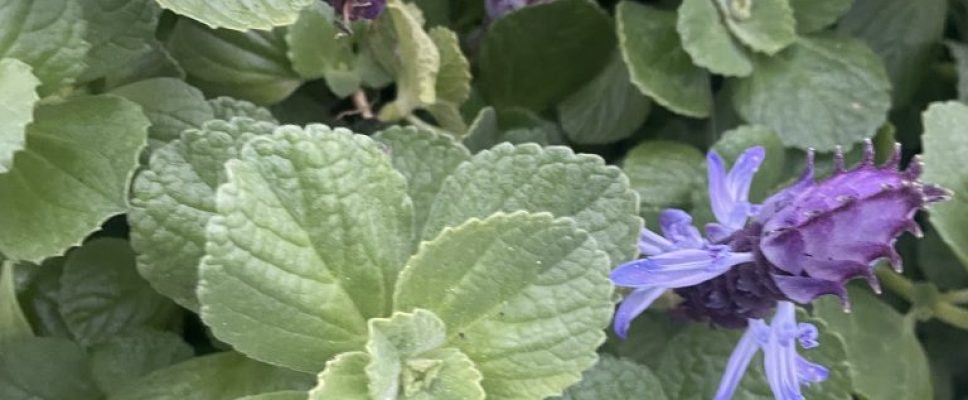
The end of another week, and Melbourne is definitely into Winter. Our Autumn planting More
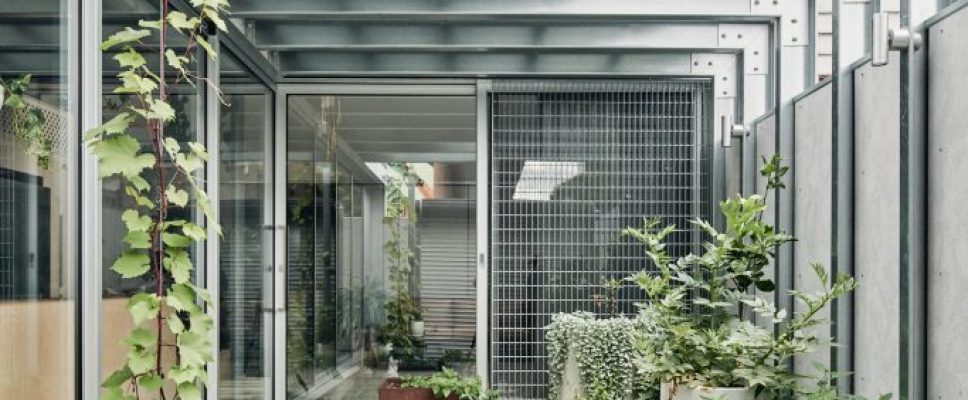
This garden is the definitive small space. Set at the rear of a renovated worker’s cottage in Cremorne, a delightful pocket of Richmond, a stones throw from the MCG, in a dense urban environment.
Our client had just completed a renovation in collaboration with FIGR Architecture Studio. Part of the brief was to create a continous interface and connection with the garden. We were delighted to design a garden that truly brings the outside in.
A small space indeed.
Formed concrete steppers with Dichondra in fill are the floor of the garden, providing a place to sit, enjoy and be in the garden, and of course a view to the garden with a seamless connection between outside and in, whilst also allowing car access to connect and charge the EV.
The steel pergola which formed part of the build gave us structure to lift the garden and provide canopy with an ornamental grape. Urbis pots from Kelloch Pots and Planters completed the garden.
The garden is captured at it’s best by Tom Blachford. Thanks also to Beatrice Whitworth who was part of the Small Spaces team.
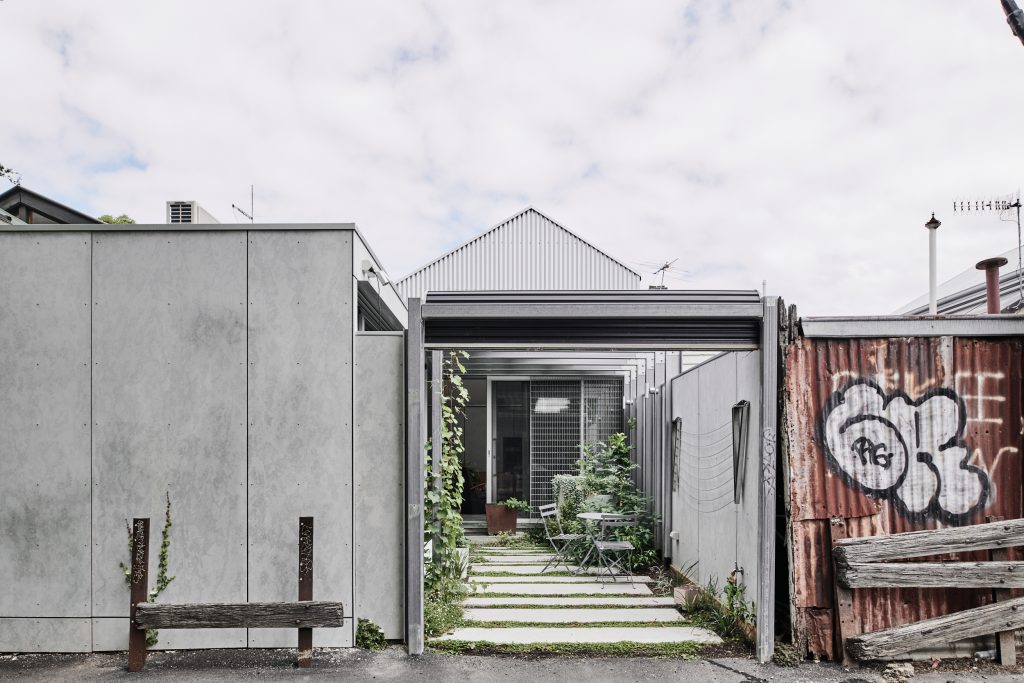
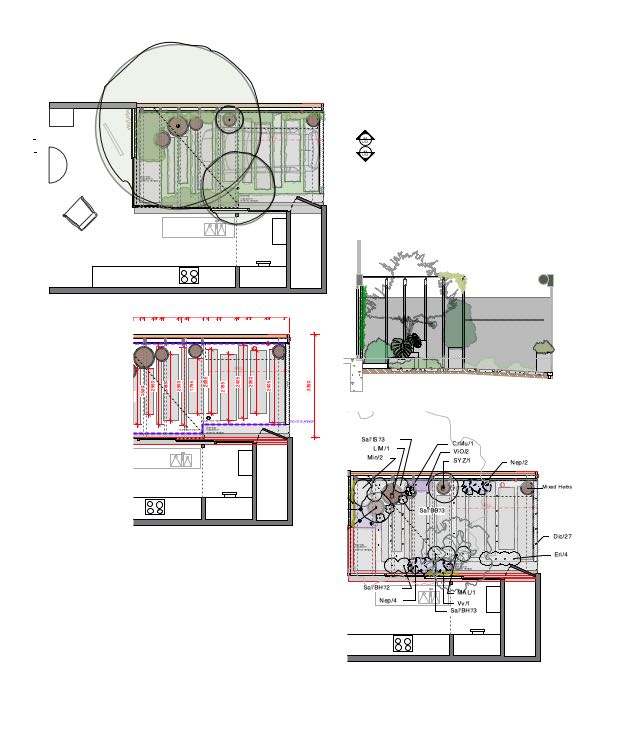
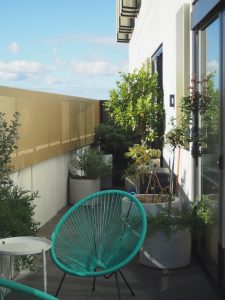 The gold balcony, so named for it’s distinctive balustrade screen, has been great to work on. The balconywraps around 2 sides of the apartment with sun coming from the north and west. So lot’s of challenges from sun and wind. There is a tap outside, which is always a bonus.
The gold balcony, so named for it’s distinctive balustrade screen, has been great to work on. The balconywraps around 2 sides of the apartment with sun coming from the north and west. So lot’s of challenges from sun and wind. There is a tap outside, which is always a bonus.
Who lives here?
Our client is a young family, who need space to sit, read a book, hang out with friends, eat together and grow their own food.
The brief covered all – create a vegie patch, somewhere to sit, maybe some green at the bedroom window and use Australian natives in the plant selection. The planting includes coastal ground covers, that will cope with both the sun and wind, a dwarf Corymbia to give a burst of colour and possibly attract the odd magpie. And, not quite native, but a Crepe Myrtle ‘Zuni’ from Flemings Nurseries which always does well in the heat and mixes in well with local plants.
The vegie patch started as 3 good sized cubes, 500x500mm, after the initial spring/summer planting, we added another to the mix. Using planters that allow a reasonable depth, both for crops to grow into and to keep the soil moisture is key in a small vegetable garden.
The balcony is long and narrow and wraps around the apartment. The design flows from the vegie garden down the west side where there’s lots of afternoon sun and a little protection from the wind. Herb pots and the BBQ are a natural tranistion to sitting areas, some comfy seats to relax in and a dining table that looks out over Victoria Park. We continued a mix of large planters in a combination of shapes from Martin Kelloch Pots
The mix in the plant selection, planters and zones has given the space a good feel. There is a subtle distinction moving through the space, that truly does create a garden.
There’s a buzz when I’m out in Collingwood and look up to see a Crepe Myrtle popping it’s head up over the gold.
This job presented Kate our head designer with a blank canvas. A new build with amazing views!
We used custom steel planter boxes and pots against the balcony walls to create different zones on the terrace. The distinct areas were for entertaining and relaxing for our clients, their 3 young adult children and the family cat. Taking into account the hot coastal winds and the fact that the site was very exposed (roof top terrace) , we used large, planter boxes to reduce the amount and speed of evaporation. A gardening rule of thumb is the more soil mass the slower it will dry out. We also installed a fully automatic irrigation system from Sunshower to the deck planters, pots from Kellock Pots and Planters and the vegetable garden.
The planters were filled with a wide range of plants and trees. Azalea, Sedum, Lavender, Coastal Correa and Seaside daisy. Herbs included Oregano, Thyme and Rosemary. Succulents including, Jade plant, Jelly bean and Aeonium ‘Schwarzkopf’ add diversity to the design. Lemon and Lime Citrus dwarf cultivars, Lilly Pilly, Crepe Myrtle and Portuguese Laurel trees add height and drama.
We were able to create a stylish, uncluttered, garden that complimented the contemporary architecture of the building. Our clients requested a design that incorporated the impressive views across to the city. Our design utilised the views to maximum effect, while still creating screening for a prominent unattractive circa 70s building and the direct views to a neighbouring apartment on the west side. 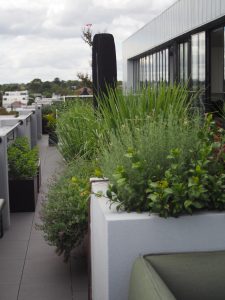
When creating the different zones the outlook of the rooms within the apartment were taken into consideration so that all had a garden view. Casual sitting areas were created for the teenagers bedrooms and the office. The end section was left more open for a workout space. And the final zone has the vegetable garden.
The results were spectacular and the clients were thrilled with the results!
Increasingly, our gardens are becoming smaller spaces, whether that means a compact back garden, a courtyard or a balcony. But this doesn’t mean you can’t have abundant greenery. A small garden can be a little oasis in the midst of our urban sprawl. You can create your own microclimate and cool your space, even grow some trees. You just need to think on a smaller scale – you might not be able to have a 20-metre lemon scented gum in your courtyard garden, but maybe you can plant a grafted variety. Look for grafted corymbia or eucalyptus, or other small tree cultivars, like crepe myrtle ‘zuni’.
The principles of garden design are essentially the same for small and large gardens. However, in a small space there is nowhere to hide, so all components need to work well. Part of having a sustainable garden is getting it right the first time: you don’t want to have to reinvent the whole thing in 12 months because what you put in the first time didn’t work.
START WITH THE FUNDAMENTALS
SOIL:
A vital ingredient of any garden is the soil. For courtyards and small backyards, My driving principle is to work with the soil that is there already. Clients often ask me to remove the existing soil and replace it with new. I usually resist this and prefer to build on what’s there; unless it’s clearly in really bad shape – full of builders rubble or contaminated from paint or concrete runoff.
If you have really sandy soil, add compost and other organic matter and over time this will build up the soil. At the opposite end of the scale, if its a heavy clay, then add gypsum.
You should also use plants that ‘like’ your soil type. For a sandy soil, choose plants that suit a coastal environment; options include westringia, leucaphyta, melaleuca, anigozanthos (kangaroo paw). Look to Western Australian natives for some inspiration. With clay soils, select plants that like poor drainage such as callistemons and bottle brushes. lomandra grasses will also cope well – they’re tough and will cope with almost anything!
One of the most important things for any soil is to add compost. This will increase the organic matter in the soil – its food for your soil. You can buy compost by the bag or make your own. Even a small courtyard or balcony can host a worm farm or Bokashi bucket on the kitchen bench which will reduce your landfill load and feed the soil at the same time.
A big part of nay small garden is likely to be pots.Use potting mix rather than soil in posts. Pots need good drainage and posting mix is designed to deliver air and water to the roots. Remember you get what you pay for. You’ve already invested in pots, planters and plants, so don’t cut short on the potting mix. Use the one that is right for your plants and check if it has fertiliser added to the mix; this can sometimes explain a difference in cost. If it doesn’t include fertiliser , then add a pelletised slow release fertiliser to your posts at the time of planting. Don’t add organic matter to potting mix as this will actual disrupt drainage and air flow; so the usual rules don’t necessarily apply.
Specialised potting mixes are particularly beneficial when planting specific groups of plants. If you are growing succulents then use a succulent mix as it has a more open structure than regular potting mix and is good for both succulents and orchids. The same goes for specialised veggie or native potting mixes; they’ve been design to cater to the specific requirements of those plants. A good all round, all purpose potting mix is ideal for small potted trees, citrus or other fruit trees.
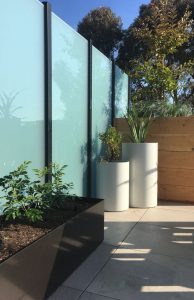
LIGHT:
As with any garden, the amount of sun your space receives will dictate what is possible to grow. Is it shady for most of the day, does it get morning or afternoon sun, or is it a full sun position? This will be dictated by aspect – which way the garden faces- and any surrounding shade.
if your garden races south or is shaded by buildings or large trees, then it may be difficult to grow veggies or fruit trees; instead, you can grow parsley, mint and basil. Citrus trees will be fine but won’t necessarily produce fruit.The sun can also heat up your walls and create a microclimate. This can work in with some plants, but it will also add to pots drying out.
WATER:
All plants need water, even succulents. Of course the amount will vary on the choice of plants but water is still essential.
It is surprising how many balconies have no access to a tap, so you may find yourself carrying a bucket or watering can to do the watering. If that’s your situation, you’ll need to think carefully about the plants you choose and how often you’ll need to water them.
Wether your garden is on a balcony or your backyard, be realistic about how often you will hand-water your pots or garden beds. If you can set up a drip irrigation system and connect it to a battery-operated timer; that way you can be assured your plants are getting watered regularly. Its not hard and there are lots of resources on-line to help you.
Alternatively consult your local specialist irrigation supplier to help you design a system that suits your needs. Take a plan of your garden to the supplier. It doesn’t need to be complex, just a rough layout with with an overall measurement of the area. They’ll also want to know your water flow – check this by timing how long it takes to fill a nine-litre bucket with the tap full on.
One of the potential pitfalls with pots is that the soil dries out and becomes hydrophobic. When this happens the water runs straight through the pot and nothing reaches the plant roots. You will see it on the ground instead. If this happens you will need to rewet the pot. In technical terms you do this via what’s called mechanical agitation or more simply, by making mud pies! Use a hose or watering can to slowly add water to the pot, and stir it in as you pour to mix the water and potting mix together. Eventually the potting mix will hold the water.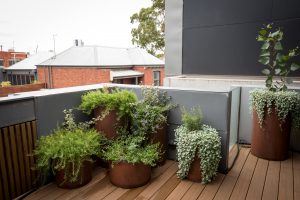 As an alternative to standard pots and planters, consider using self-wicking pots, which have a reservoir of water under them which ‘wicks’ up to water the plants. Theses are ideal for balconies as they require less frequent watering and delivers water directly to the roots!
As an alternative to standard pots and planters, consider using self-wicking pots, which have a reservoir of water under them which ‘wicks’ up to water the plants. Theses are ideal for balconies as they require less frequent watering and delivers water directly to the roots!
Extract of article that first appeared in Sanctuary Magazine issue 36 words by Kate Smalley – Small Spaces garden design, head designer and managing director.
There are more outdoor paving options than you may think, and environmental and financial costs can be high. Careful consideration should be taken for hard- wearing surfaces with timeless appeal.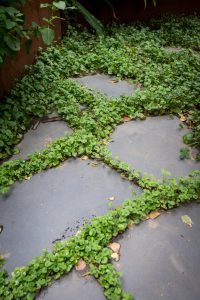
Planning the hard landscaping or built components of your garden may present many of the same dilemmas faced when building or renovating. Just as you might scrutinise the source, embodied energy and durability of your building materials, you should apply the same eagle eye to your paving choices. The purpose of the paving will obviously also influence your choice of product, and of course aesthetic is essential. If it doesn’t look good, its likely to be removed and replaced down the track with additional financial and environmental costs.
Your materials choice should be influenced by both the style of the building and what’s already in your garden. The garden should be an extension of the building it surrounds, and for the two to complement each other there needs to be continuity, both in the materials used and the and the landscape design. For example, a brick house or a house with brick detail in the finish, could see this detail replicated through the paving. This could be in the form of a border for a gravel driveway or concrete paved space, or could be woven throughout the other elements as a pattern. You should be able to match your brickwork through a recycling yard or manufacturer with relative ease.
Aside from design issues, there is also the practicality of the material to be used the permeability of the base. A permeable base, which which allows rainfall to soak into the ground, is preferable. The increasing amount of impermeable hard surfacing in our cities and suburbs has an impact on surface water flooding and river pollution, and can also reduce ground water levels with wider ecological impacts.
The source of the materials used is also important. Most landscaping materials have come out of the ground at some stage, so we need to consider the where, what and how versus the longevity of the finished product. As with all building products, opting for recycled materials can help reduce demand for the virgin product. Transport miles from quarries to distribution centres and to the site should also be considered. For more sustainable tips, see www.aila.org.au/materials
Extract of article that first appeared in Sanctuary Magazine issue 28 words by Kate Smalley – Small Spaces Garden Design, Managing director.
We designed a smart layout that was striking and functional. Kate (Small Spaces head designer) suggested a curved garden wall that would create a border for garden beds as well as raised seating. This seating could be used when hosting friends and family alfresco. The retaining walls and raised beds can pull double duty if they are at seating height and softened with cushions or a folded blanket. Perfect for entertaining.
The curved wall also added extra dimensions to the overall aesthetics of the space. Creating structure and interesting lines.
Clean lines bring an orderly feel to the garden. The use of flowing organic curves was used to soften awkward angles and the severity of the concrete. We think the outcome was excellent.
The curved line of the garden wall was continued at ground level to create a semi enclosed area for the clothesline as well as a herb and vegie garden, with a second sitting area.
A concrete wall is rotproof, rustproof and fireproof and, if built correctly, will last for decades. An environmentally friendly option as it is made from natural materials, such as clay and limestone, in many are locally sourced.
Random paving stones with open ground covers and herbs were used to create stunning pathways through the garden and along the side of the house.
We painted the fences “monument grey” to create drama and a perfect backdrop to amplify the colours of the flowers in the raised garden beds, and contrast the grey of the concrete and paving stones.
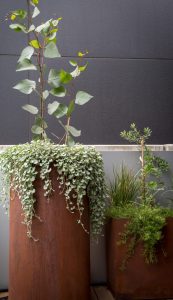
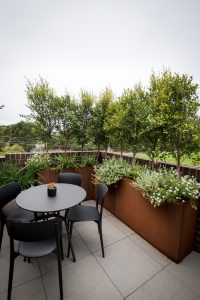
Corten steel planter boxes are functional, sustainable and enhance the aesthetics of a well designed small garden space. Planter boxes create scale, height, shape and drama.
Corten steel is the common name for weathering steele which is designed to develop a thin layer of rust that acts as a protective coating. The patina that Corten steel acquires as it ages works beautifully with wood, stone, grasses, concretes and of course plants and trees.
Small Spaces love the variations of texture and the fact that planter boxes can be designed and built to bespoke dimensions for all spaces. The patina of bronze, rust and copper hues it develops as it ages compliment both naturalistic and architectural designs.
Both low maintenance and longevity are major benefits of using Corten Steele in the garden. It should be left unfinished – Not painted or waxed as it is corrosion resistant and develops character as it ages. If damaged or scratched the material will soon smooth over to cover the visible marks. The rust serves as a protective coating.
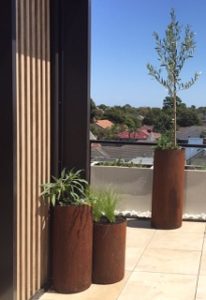
When working in a small space such as courtyards, patios & rooftops the Steele planters can create statement pieces that will really draw the eye and enhance the aesthetic contrast of the garden design by adding height, shape and structure to an area with limited space.
Here at Small Spaces we can incorporate a corten steel element into your garden design. The possibilities are almost endless!
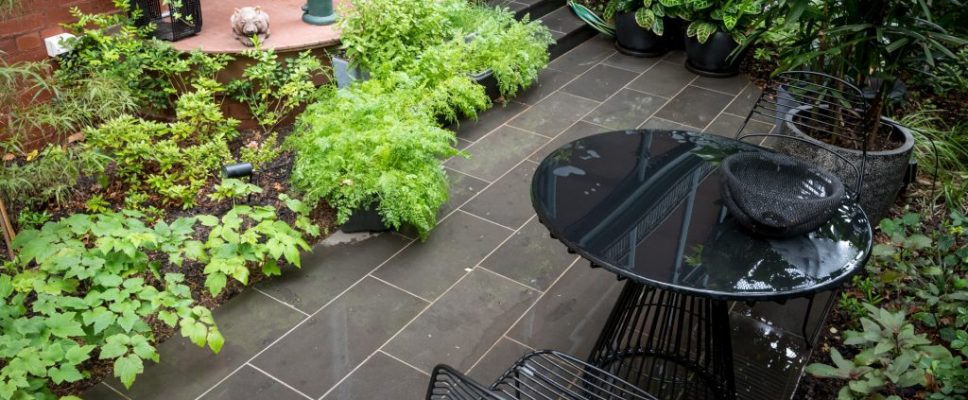
In 2018 we were charged with creating a courtyard sanctuary in inner city Melbourne where our clients could sit and watch the passing parade but still have privacy. As their apartment was small, the courtyard needed to be designed to function as an outdoor room as well as a garden.
Working with the clients we designed a beautiful green space utilising bluestone paving for the flooring and Lilly Pilly’s to create a living screen between their property and the neighbours. The original hedge that ran along the front fence was unattractive, gnarly and did not offer privacy due to its poor condition. After tip pruning, fertilising and installing a drip irrigation system that supplied water directly to the root zone it returned to its former glory! We installed a floating bench seat along the back of the hedge. This could be used for private relaxation or seating for a larger group when our clients are hosting friends and the weather was conducive to entertaining.
The clients requested a simple green, full, lush garden layered top to bottom.
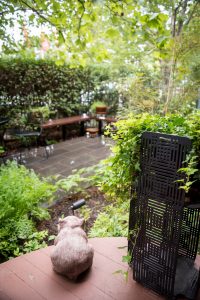
We suggested they add a water feature to offset the city noise which we sourced from Kelloch Pots and Planters in Seaford, https://www.kellockpotsandplanters.com.au
We integrated lighting to illuminate paths for security and safety as well creating depth. Good lighting also allowed for our clients to utilise the space at night.
During COVID 19, Small Spaces is still operating and we are keen to help out with advice on your garden. You can still start the design process while we are in lockdown. We can arrange a garden consultation on line, and walk through your garden remotely.
More